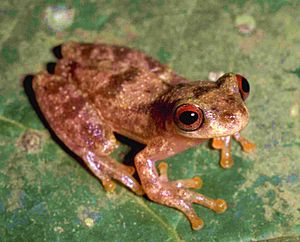Dendropsophus joannae facts for kids
Quick facts for kids Dendropsophus joannae |
|
|---|---|
 |
|
| Conservation status | |
| Scientific classification | |
| Synonyms | |
|
The Dendropsophus joannae is a type of frog that belongs to the Hylidae family, also known as tree frogs. You can find this small frog in parts of South America. It lives in northern Bolivia, western Brazil (in the Acre and Amazonas states), and southeastern Peru (in the Madre de Dios Region).
This frog looks a bit like another frog called Dendropsophus leali. However, the Dendropsophus joannae is smaller. It also has a shorter nose (snout), eyes that stick out more, and bumpier skin on its back. The name joannae was chosen to honor Mrs. Jo Ann Oxley Foster. She is a supporter of BIOPAT – Patrons for Biodiversity, an organization that helps with animal research and protecting nature.
What Does It Look Like?
Male Dendropsophus joannae frogs are about 1.5 to 1.9 centimeters (0.6 to 0.75 inches) long. Female frogs are a bit bigger, around 2 to 2.1 centimeters (0.8 to 0.83 inches) long. These measurements are from their snout (nose) to their vent (bottom).
This frog has a slim body and a rounded snout. It has clear eardrums, which are called the tympanum. There is also a fold of skin above its eardrum. Its fingers and toes are short and have big, round sticky pads. These pads help the frog climb. Its fingers are about two-fifths (40%) webbed, and its toes are about four-fifths (80%) webbed.
The skin on its back is usually grayish or yellowish-tan. It has brown marks on it. The sticky pads on its fingers and toes are bright yellow on top. The skin on the underside of its legs and belly is almost see-through. Its chest is a creamy color, and its throat is yellowish. The inner part of its eye (the iris) is red, with a thin tan ring around it.
Where It Lives and How It's Protected
The Dendropsophus joannae frog lives in open areas. These places often have tall grass around small ponds and ditches next to roads. They are found at elevations of about 238 to 250 meters (781 to 820 feet) above sea level. It is believed that these frogs lay their eggs and have their young in these ponds and ditches.
This frog seems to be good at adapting to different environments. Scientists believe it is not currently facing any major threats to its survival. It also lives in several protected areas in Brazil, which helps keep its populations safe.
See also
 In Spanish: Dendropsophus joannae para niños
In Spanish: Dendropsophus joannae para niños


